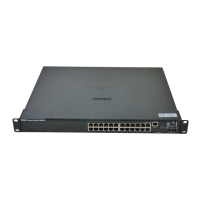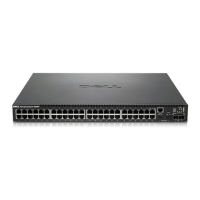357
An excessive amount of broadcast messages simultaneously transmitted across a network by a single port.
Forwarded message responses are heaped onto the network, overloading network resources or causing the
network to time out.
For more information about broadcast storms, see "Defining LAG Parameters".
C
CDB
Configuration Data Base.
A file containing a device’s configuration information.
Class of Service
Class of Service (CoS).
Class of Service is the 802.1p priority scheme. CoS provides a method for tagging packets
with priority information. A CoS value between 0-7 is added to the Layer II header of packets, where zero is the
lowest priority and seven is the highest.
A overlapping transmission of two or more packets that collide. The data transmitted cannot be used, and the
session is restarted.
Combo Ports
A single logical port with two physical connections, including an RJ-45 connection and an SFP connection.
CLI
Command Line Interface
. A set of line commands used to configure the system. For more information on using
the CLI, see
Using the CLI
.
Communities
Specifies a group of users which retains the same system access rights.
CPU
Central Processing Unit
. The part of a computer that processes information. CPUs are composed of a control
unit and an ALU.
D
DHCP Client
An Internet host using DHCP to obtain configuration parameters, such as a network address.
DSCP
DiffServe Code Point (DSCP)
. DSCP provides a method of tagging IP packets with QoS priority information.
Domain
A group of computers and devices on a network that are grouped with common rules and procedures.
Duplex Mode
Permits simultaneous transmissions and reception of data. There are two different types of duplex mode:

